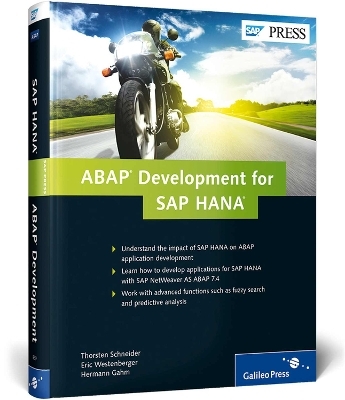
ABAP Development for SAP HANA
SAP Press (Verlag)
978-1-59229-859-4 (ISBN)
- Titel ist leider vergriffen;
keine Neuauflage - Artikel merken
Analyzing and Optimizing Existing Applications Get step-by-step guidance that will help you to detect performance optimization potential in existing ABAP applications, and learn how to speed them up by using SAP HANA properly. Building Innovative New Applications Go beyond traditional database platforms with SAP HANA offerings. Find what you need to build and support innovative business processes.
Hermann Gahm is an SAP Support Consultant in the Technology & Performance area, and he has worked in the Active Global Support department of SAP AG since 2007. His tasks focus on the support of major SAP customers with regard to performance problems within the scope of ABAP developments for CPO (Customer Program Optimization) and BPPO services (Business Process Performance Optimization). While working as an ABAP developer at one of the largest commercial enterprises in Germany and as an SAP system administrator at the industry-leading enterprise for processing industrial credit and building society savings products, he finished his further training as an expert in business data processing at the IHK (German Chamber of Commerce and Industry). Here, his work focused on the performance analysis and optimization of mass data processing in SAP systems.He then joined SAP SI AG as an SAP technology consultant where he took over responsibility for various system, database, and ABAP program tuning projects for national and international customers.
Foreword. 15
Preface. 17
Introduction. 19
PART I: Basic Principles. 27
1. Overview of SAP HANA. 29
1.1. Software Components of SAP HANA. 29
1.2. Basic Principles of In-Memory Technology. 37
1.3. Architecture of the In-Memory Database. 51
1.4. Application Cases for SAP HANA. 53
1.5. How SAP HANA Affects Application Development. 56
2. Introducing the Development Environment. 63
2.1. Overview of Eclipse. 63
2.2. SAP's Eclipse Strategy. 66
2.3. Installing the Development Environment. 69
2.4. Getting Started in the Development System. 72
3. Database Programming Using SAP NetWeaver AS ABAP. 103
3.1. SAP NetWeaver AS ABAP Architecture. 105
3.2. ABAP Database Access. 116
3.3. Analyzing Database Accesses Using the SQL Trace. 143
PART II: Introduction to ABAP Programming with SAP HANA. 155
4. View Modeling in SAP HANA Studio. 157
4.1. Attribute Views. 160
4.2. Analytic Views. 180
4.3. Calculation Views. 192
4.4. Accessing Column Views via Microsoft Excel. 203
4.5. Using SAP HANA Views in ABAP. 205
5. Programming Options in SAP HANA. 215
5.1. Overview of SQLScript. 215
5.2. Implementing Database Procedures. 223
5.3. Using Procedures in ABAP. 255
6. Application Transport. 269
6.1. Basic Principles of the Transport System. 271
6.2. Combined ABAP/SAP HANA Transport. 285
7. Runtime and Error Analysis with SAP HANA. 293
7.1. Overview of the Tools Available. 294
7.2. Error Analysis. 296
7.3. ABAP Code Analysis. 305
7.4. Runtime Statistics and Traces. 313
7.5. System-Wide SQL Analyses. 337
7.6. SQL Performance Optimization. 346
8. Sample Scenario: Optimizing an Existing Application. 351
8.1. Optimization Procedure. 351
8.2. Scenario and Requirements. 357
8.3. Meeting the Requirements. 362
PART III: Advanced Techniques for ABAP Programming for SAP HANA. 381
9. Text Search and Analysis of Unstructured Data. 383
9.1. Basic Principles of the Text Search in SAP HANA. 385
9.2. Types of Text Data and Full Text Indexes in SAP HANA. 390
9.3. Using the Text Search via SQL. 395
9.4. Using the Text Search in ABAP. 407
9.5. Text Analysis. 416
9.6. Resource Consumption and Runtime Aspects of the Text Search. 418
10. Integrating Analytical Functionality. 423
10.1. Introduction. 423
10.2. Overview of Possible Architectures. 429
10.3. Selected Technologies and Tools. 439
10.4. User Interface Building Blocks. 453
11. Decision Tables in SAP HANA. 455
11.1. Basic Principles of Decision Tables. 456
11.2. Creating Decision Tables in SAP HANA Studio. 459
11.3. Decision Tables Based on SAP HANA Views. 465
11.4. Runtime Artifacts and SQL Access for Decision Tables. 468
11.5. Access to Decision Tables from ABAP. 468
12. Function Libraries in SAP HANA. 473
12.1. Basics of the Application Function Library. 476
12.2. Use of Application Function Library Functions in SQLScript. 483
12.3. Integration of Function Libraries in ABAP. 487
13. Sample Scenario: Development of a New Application. 491
13.1. Scenario and Requirements. 491
13.2. Application Design. 492
13.3. Implementation of the Application. 497
13.4. Using the Applications. 506
14. Practical Tips. 509
14.1. General Recommendations. 510
14.2. Conventions. 520
14.3. Quality Aspects. 523
14.4. Performance Recommendations for Open SQL. 526
14.5. Performance Recommendations for Native Implementations in SAP HANA. 551
14.6. Summary of Recommendations. 558
Appendices. 561
A. Flight Data Model. 563
B. What's New in ABAP in SAP NetWeaver 7.4. 573
C. Read and Write Access in the Column Store. 579
D. SAP Business Application Accelerator Powered by SAP HANA. 589
E. Installing the Sample Programs. 593
F. The Authors. 595
Index. 597
| Reihe/Serie | SAP PRESS Englisch |
|---|---|
| Verlagsort | Maryland |
| Sprache | englisch |
| Themenwelt | Mathematik / Informatik ► Informatik ► Netzwerke |
| Mathematik / Informatik ► Informatik ► Programmiersprachen / -werkzeuge | |
| Informatik ► Weitere Themen ► SAP | |
| ISBN-10 | 1-59229-859-1 / 1592298591 |
| ISBN-13 | 978-1-59229-859-4 / 9781592298594 |
| Zustand | Neuware |
| Informationen gemäß Produktsicherheitsverordnung (GPSR) | |
| Haben Sie eine Frage zum Produkt? |
aus dem Bereich



